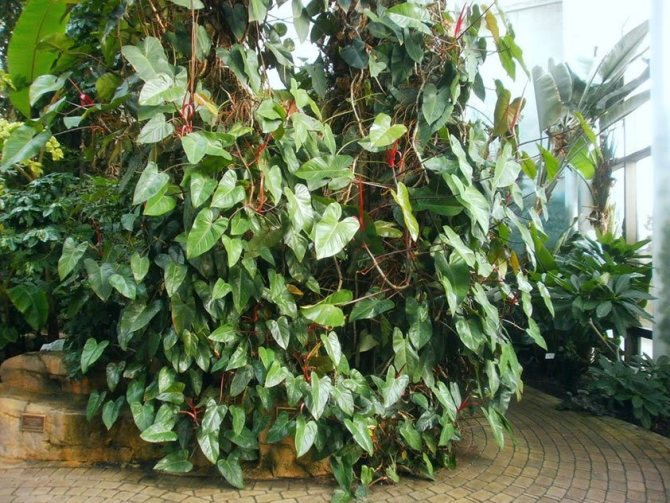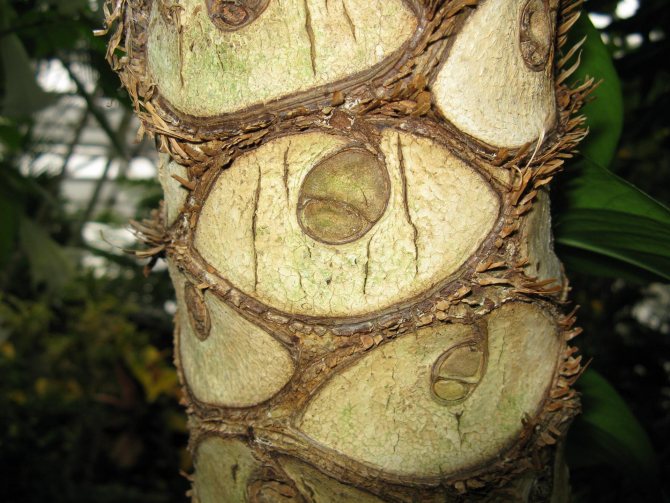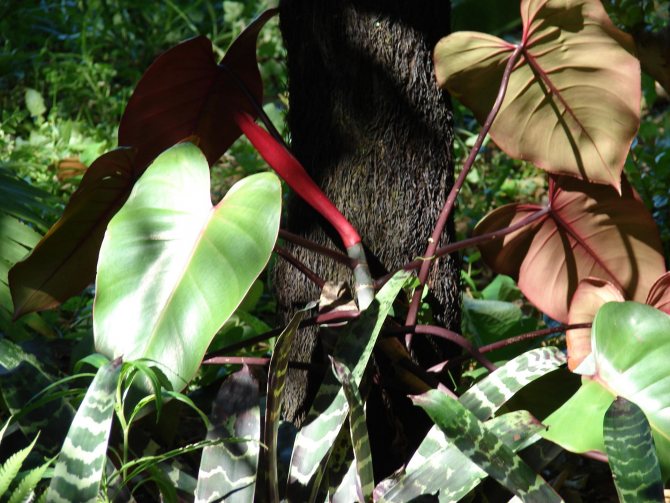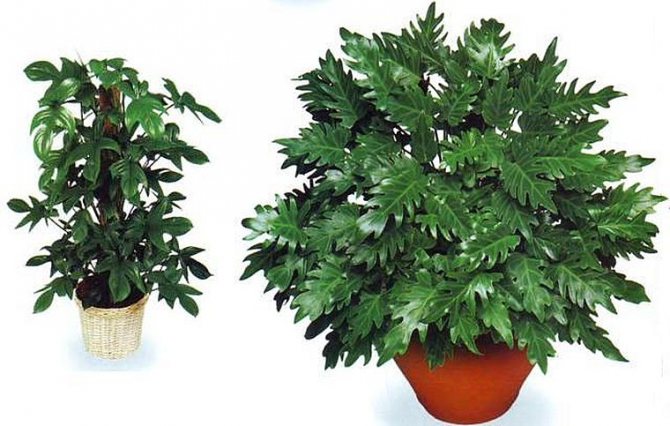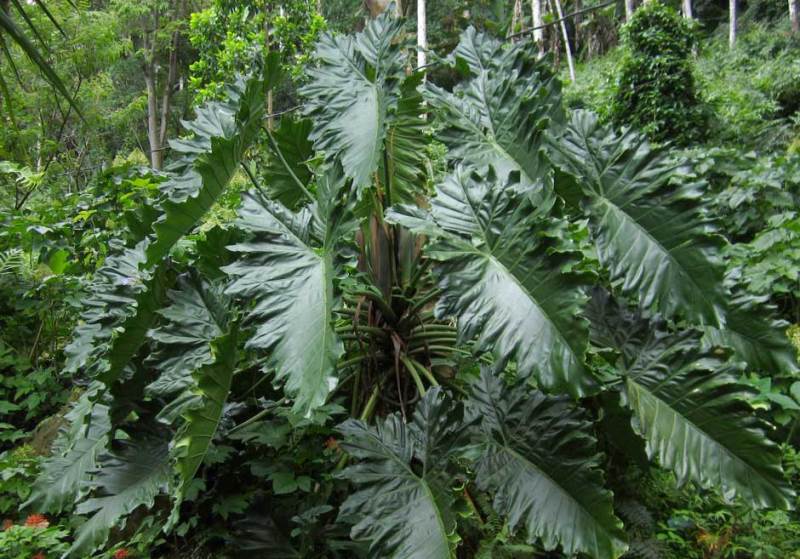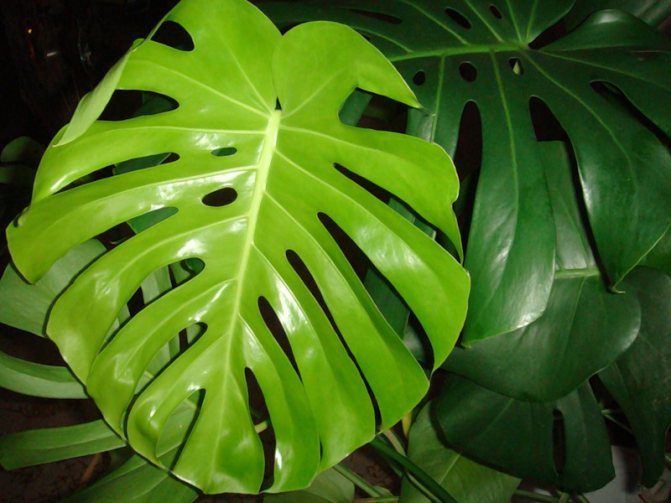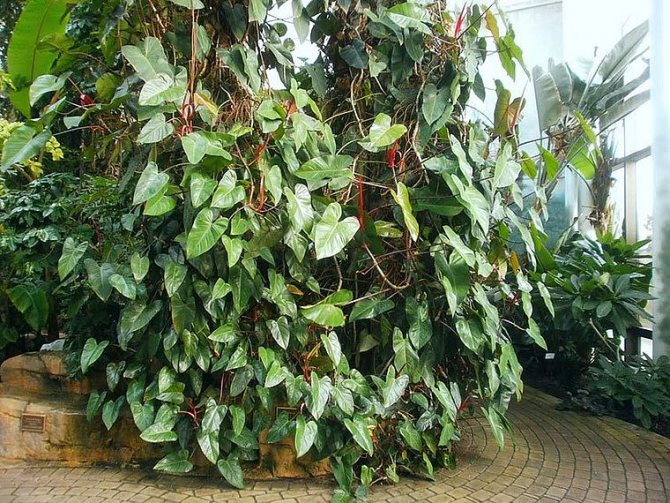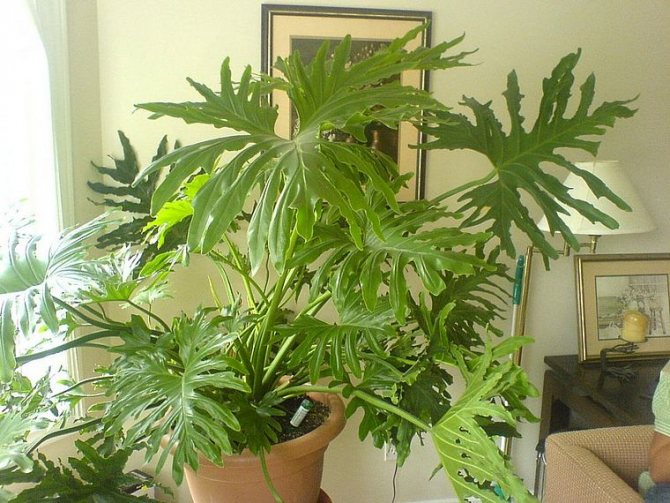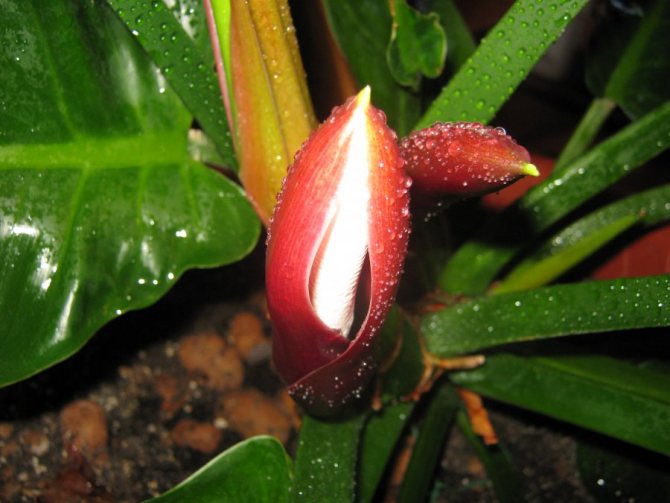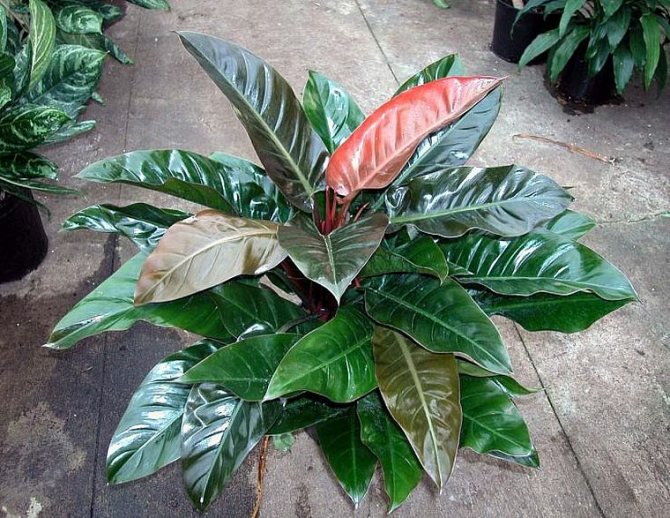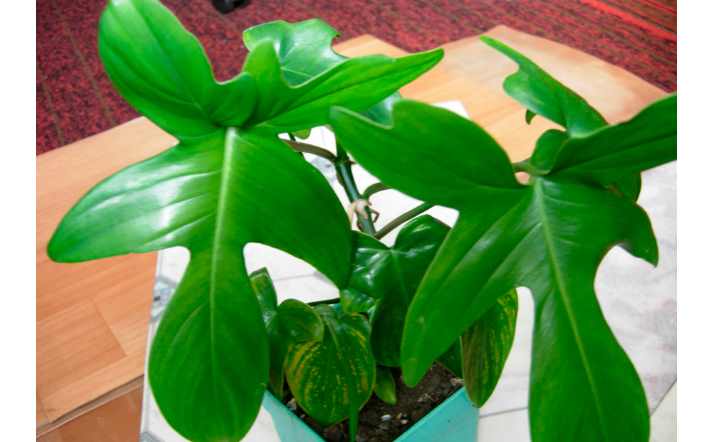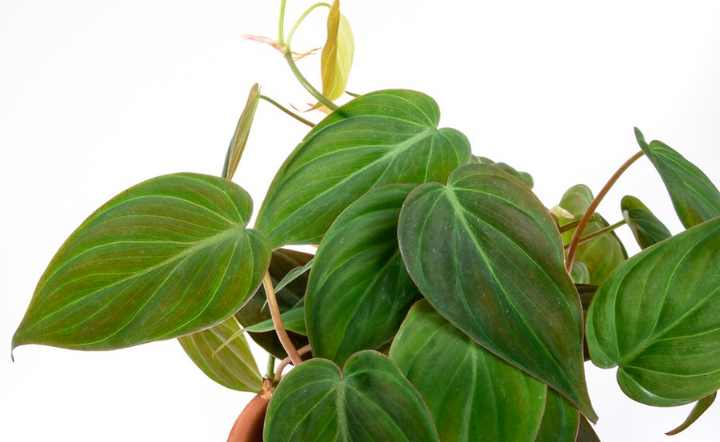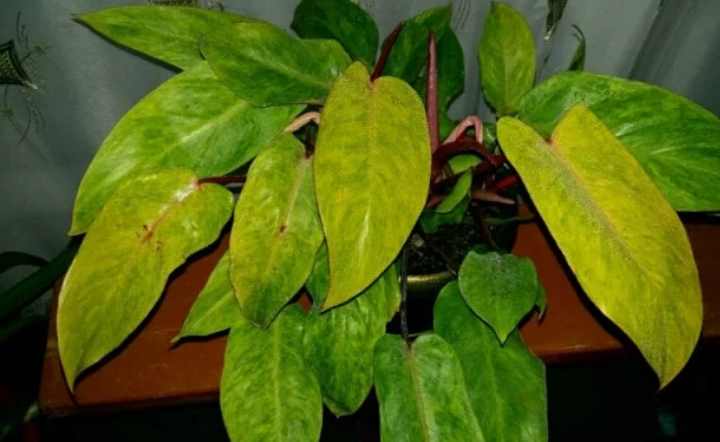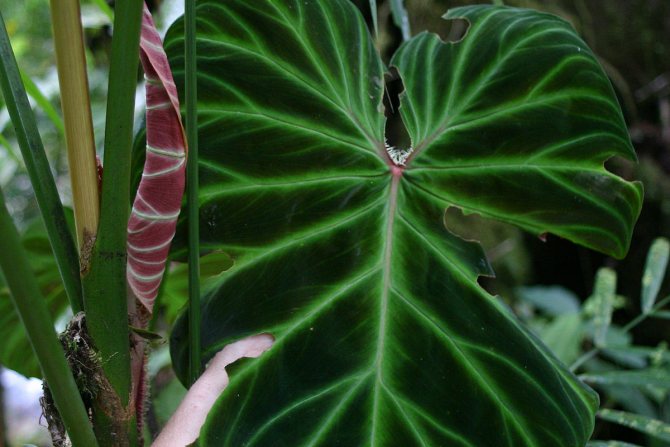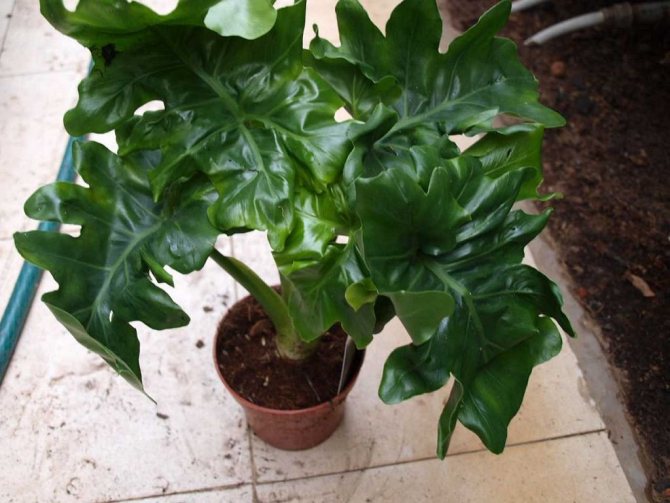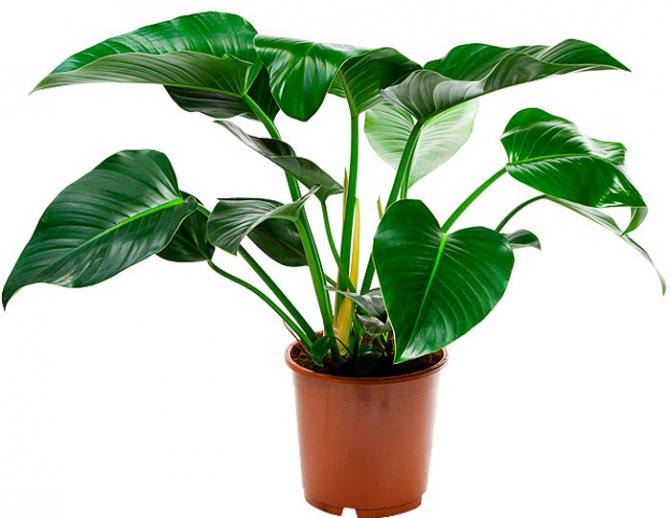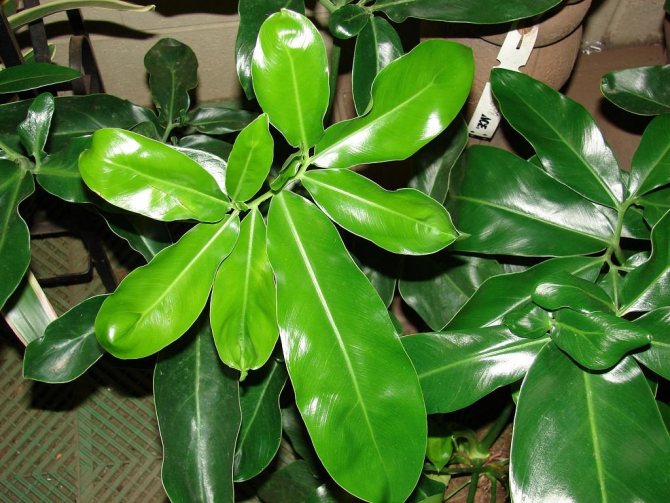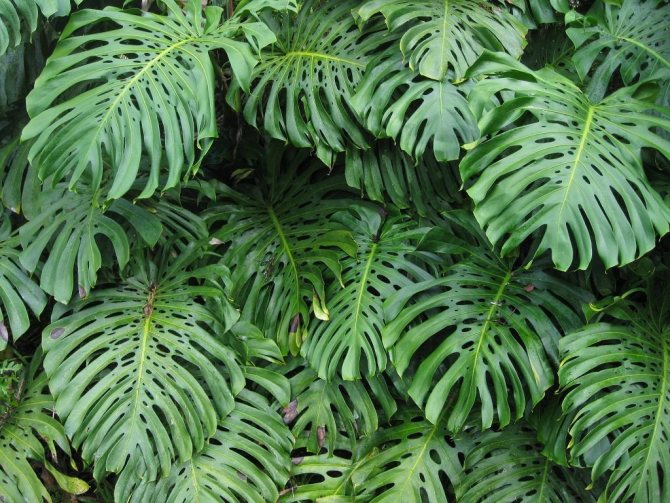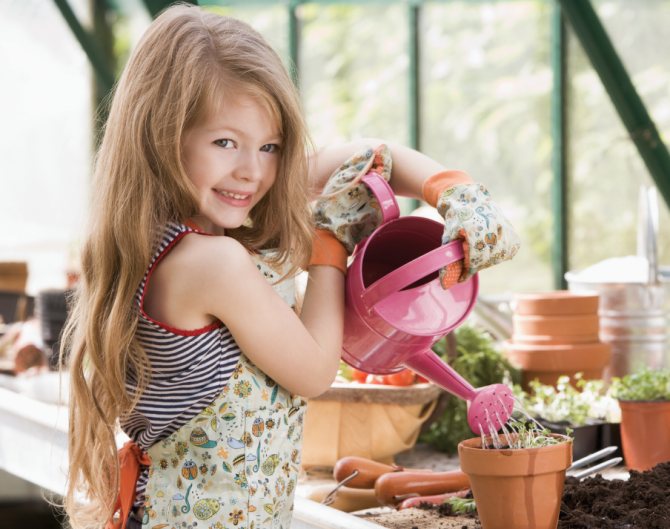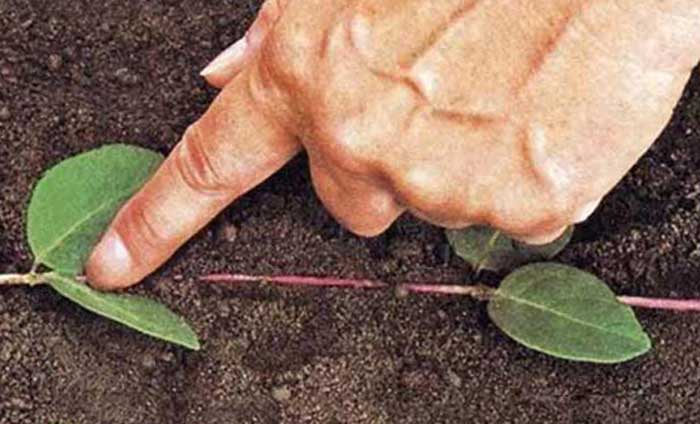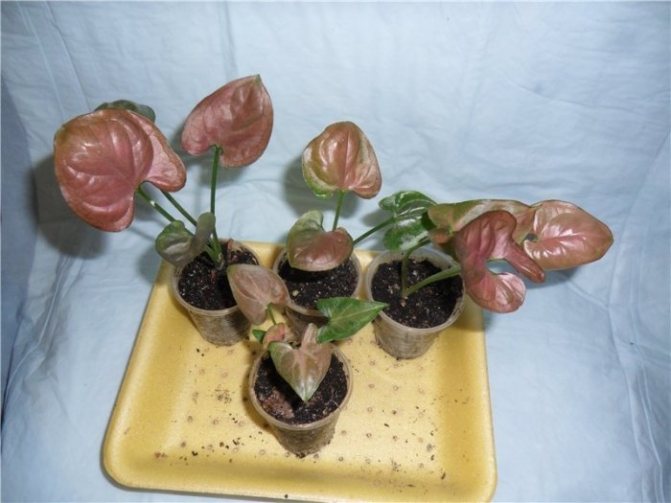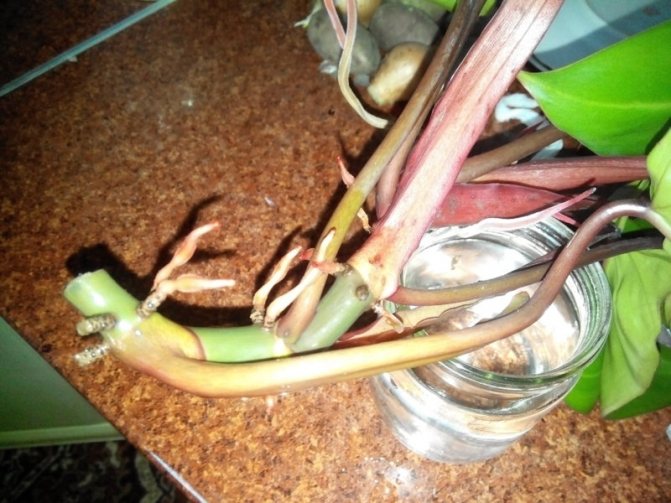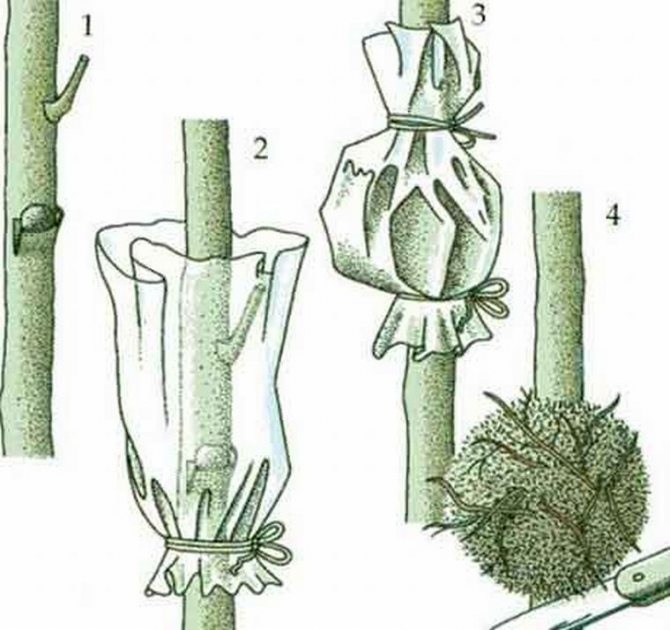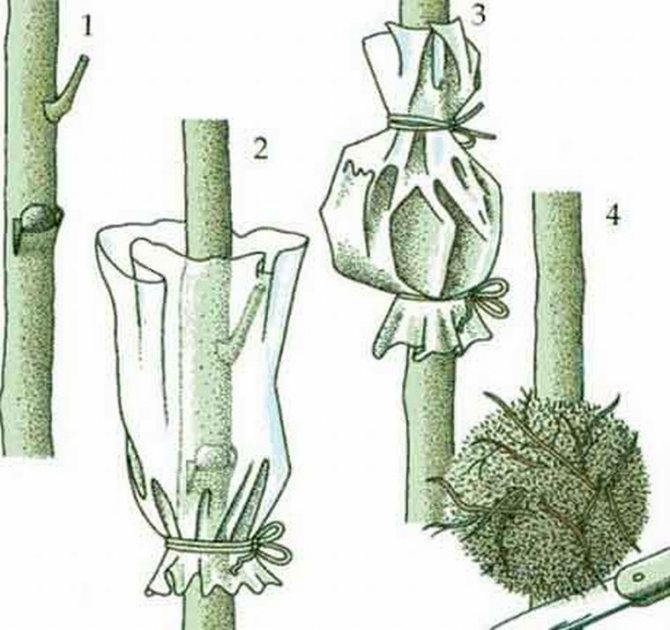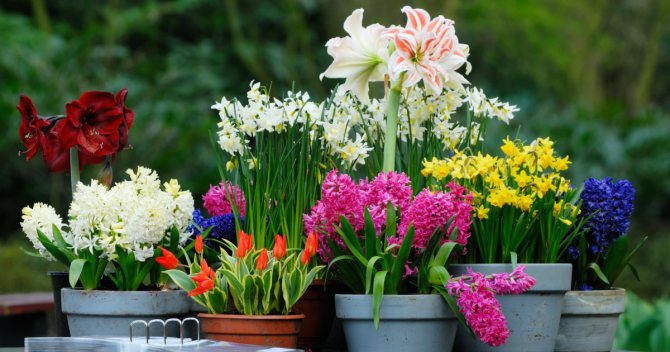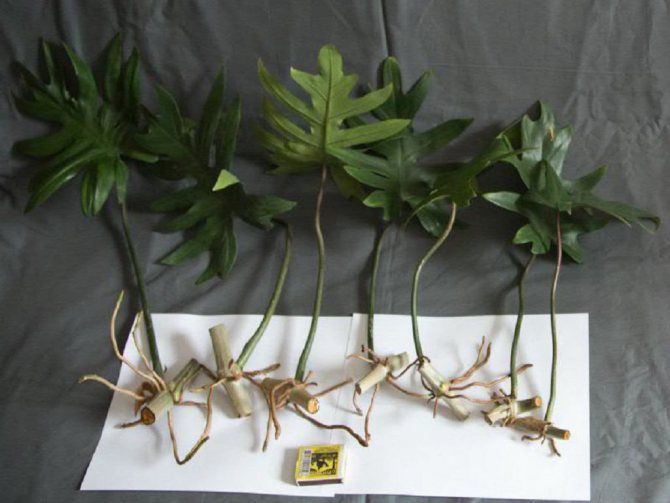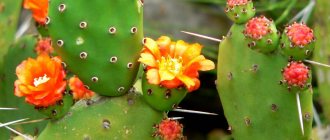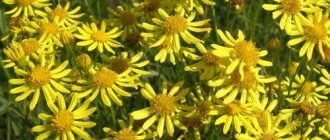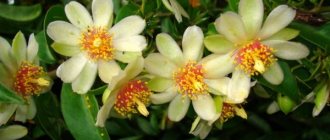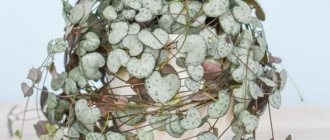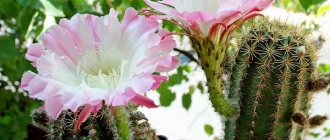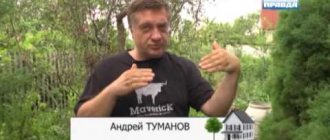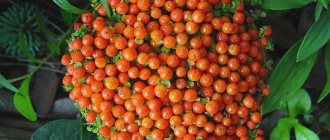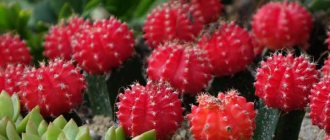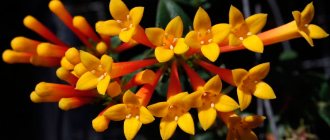Philodendron is one of the most attractive perennial and evergreen plants that belongs to the genus Aroids, which means "love" in Latin. In total, this genus includes about 900 plants. In nature, the flower is found from Mexico to the tropical USA. Most varieties prefer to grow in rainforests, but there are some that can be seen in swamps or roadsides. Also, many of them are suitable for breeding in European latitudes in indoor conditions and greenhouses.
Can a philodendron be kept at home?
Superstitious and overly cautious growers do not recommend keeping the philodendron at home.
The first category of such advisors is guided by signs. It is believed that the philodendron refers to plants - "muzhegon", provoking quarrels and the subsequent departure of the spouse from the family. Especially in this regard, they slander the climbing philodendron - one of the most popular domestic species.
The second category of gardeners relies on one simple fact in their beliefs: philodendron juice is poisonous... Therefore, if you really start such a tropical handsome man at home, you should work with them with gloves so that the juice does not irritate the skin.
You should not believe in omens, but you must adhere to the main rule of all young parents and pet owners: keep a poisonous vine where babies and four-legged pets cannot reach it. If there is no such inaccessible place where you could "hide" the philodendron, you should postpone or refuse to acquire it.
But there is also a benefit from a poisonous vine: the philodendron is included in the list of plants that are the best at cleaning the air. In particular, it removes formaldehyde and xylene from the atmosphere.
Botanical description
Philodendrons belong to the Aroid family. The evergreen climbing perennial is fixed to the support thanks to the sucker roots. The fleshy stems are lignified at the base. The foliage is quite dense, leathery, characterized by a variety of size characteristics, shapes and colors. The length of a philodendron growing at home reaches 200-240 cm.
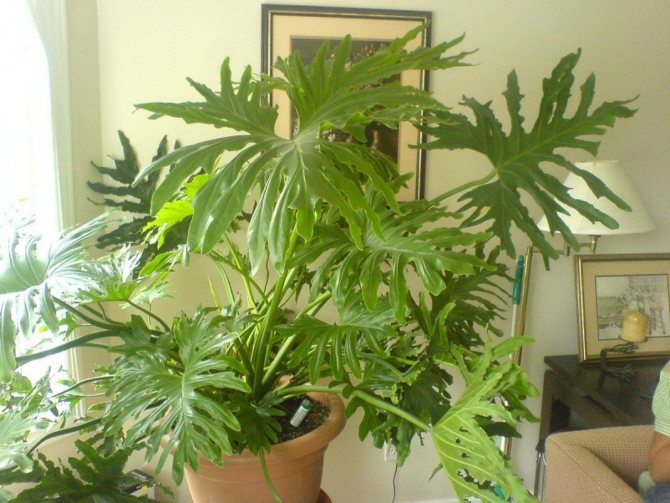
What does a flower look like
How the structure of the shoots occurs is still a mystery to this day. The foliage of the two types develops in turn. First of all, in the philodendron, the development of a scaly green mass is carried out. After this, the process of development of green leaves on long petioles begins. In the inner part of the green foliage, the formation of rudimentary inflorescences occurs. Lateral buds develop in the axils of scaly sheets.
Note! The main shoots end with inflorescences. Where parts of the stems that bear the following scaly and green leaves grow from is unknown.
The main types and names of varieties of philodendron with a photo
Philodendron climbing (aka clinging) is one of the most common plant species. It is not difficult to guess from the photo that it is often grown in hanging pots. It is a vine with thin stems and not very large green leaves: 15 cm long and up to 10 cm wide. They are usually heart-shaped and leathery. There are varieties of this philodendron with glossy leaves, which at first may have a reddish tint.
Blushing (or reddish) - climbing philodendron with short internodes and a thick stem. As you can see in the photo, it does not branch and is entirely covered with large leaves up to 25 cm long. They have an arrow-shaped or ovoid triangular shape. Young ones are green with pink edges, after which they acquire a dark red color. Cataphylls, in turn, have a pure red color.
The trunk of a blushing philodendron turns from red-green to gray over time. Shoots are characterized by increased fragility. The flower has a strong scent. He himself is white, and the bedspread is dark red.
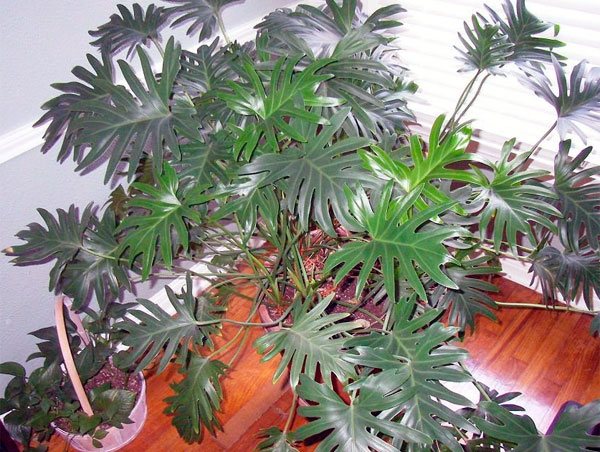

Philodendron Sello (he is double-feathery or double-periston cut) - this is a vine with a gradually woody stem. It is smooth to the touch and can be up to 3 meters long. After falling leaves, light oval traces remain, which form a bizarre pattern on its surface.
Leaves on long petioles have a triangular or smoother heart-shaped shape with a deep double pinnate dissection (see photo). Their length is about 90 cm, the color is most often pure green or with a gray tint. A typical representative of the philodendron sello is the "Mexican serpent", one of the popular domestic philodendrons.
Ivy Is a climbing philodendron that can grow up to 6 meters in length. Its broad leaves are heart-shaped and can grow up to 30 cm in length. They are leathery and glossy to the touch, and most often have a dark green tint in color. The flowers have green veils and red ears of any shade - from light to dark. The fruits are white-green berries.
Philodendron Xanadu is tree-like. Its rounded leaves are dissected and can grow up to 40 cm in length. The flower has a bright purple-red veil, but blooms very rarely at home.
Radiant philodendron is a creeping vine. The leaves are arranged on long and rounded petioles, as shown in the photo. At home, the leaf plate usually does not grow longer than 20 cm. Its shape changes greatly with age: from whole leaves they turn into dissected ones, they are pinnate. They are usually green in color, but glossy to the touch.
Philodendron atom resembles a shrub in shape. It has a fairly compact size, while admiring its decorative effect. Its five-lobed leaves are wavy curved. They have a glossy sheen and bright green color. A great option for small apartments, as this species grows very slowly.
Skandens - climbing and little branching species. This vine is one of the most shade-tolerant among philodendrons. Her leaves are green, heart-shaped, have a glossy sheen.
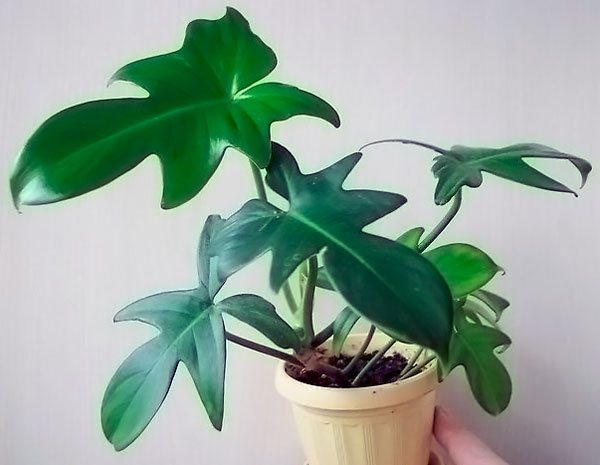

Lobular philodendron - climbing liana with dark green foliage. Leathery glossy leaves have an ovoid shape, which can turn into three dissected. Then it can be divided into five parts, all this can be seen in the photo of the plant. The petioles are approximately equal to the length of the leaf - from 10 to 40 cm. Flexible branches are of average thickness.
There are two kinds imperials - ed and green. Philodendron imperial is distinguished by a stem with short internodes and large oval leaves. They are dark red in Red and dark green in Green. Its flowers are usually collected in a rosette, the diameter of which can reach a meter.
Spear philodendron Is a fast-growing liana with spear-shaped leaves. They are glossy, grow up to 40 cm in length, and are green in color. With age, they may acquire notches at the base and some waviness.
Philodendron Cobra refers to the droplet species. It has oblong leaves with pointed ends. If the vine spreads, the leaves are unlikely to grow more than 14 cm, but with vertical growth they can reach 25 cm in length. They are green in color, the Cobra may have light decorative spots on the plate.
Guitar-shaped (or two-leafed) philodendron can grow up to 2 meters in length, so it needs support. In adolescence, the foliage has the shape of a heart, then it acquires a deep-lobed shape with a "waist", which makes the leaf look like a guitar.
Jellyfish is a very striking species. Its leaves are yellow, and the petioles and stems are red.
Mediopict - a liana of light green color with neat heart-shaped leaves.
Burle Marks - a well-branched bush. Very shiny glossy green leaves are located on long petioles.
Warty philodendron - fragile vine. Leaves - "hearts" can grow up to 60 cm in length. They are colored very variegated. The main part of the leaf has some shade of green (for example, olive or emerald green). In the upper part, the leaves may differ from the main color with a brown tint, pass along the vein with a fawn tint, and in the lower part have a brown color with a red tint. The long petiole is also colored red and covered with warty villi.
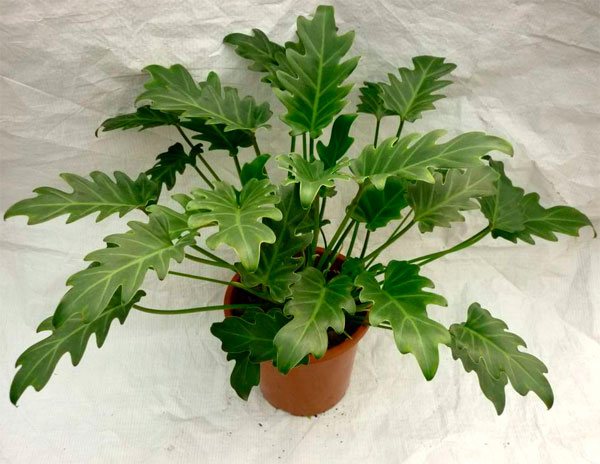

Elegant (or elegant) philodendron is a large liana, the stem that gradually lignes, but does not branch. Large and wide leaves are dark green, oval and deep feathery dissection.
Philodendron "Blushing" (erubescens)
The plant "Reddening" philodendron (erubescens) grows up to 2 m in height, has arrow-shaped leaves of dark green color, and leaf petioles have a dark light color. The trunk of the plant is red-green, but when it becomes lignified, it changes to a gray-golden color. The presented species is the owner of aerial roots, which must be carefully tucked into moist moss. A curved wire should be used to attach the roots so that the roots are not damaged during growth.
This type of flower will perfectly tolerate a prolonged absence of water. However, it is important to spray it frequently. Loves shade and does not tolerate drafts, feels good at a temperature of 13 ºC. In general, the "Reddening" philodendron requires the same care as any other plants presented in the article above.
What you need to know if you want to buy a philodendron
Even if you buy a philodendron from a specialty store, you cannot be sure which variety you are taking. This is due to the above-described property of vines to change the color and shape of their leaves over time and thereby mislead even experienced flower growers. Although you can still try to determine the variety, because some of them have very characteristic differences.
Next, you should focus on the health of the selected philodendron and carefully examine it. Its leaves should not be lethargic or damaged, they should not have spots or dry edges. The stem should also be clean, with no signs of rotting or drying out. Check the plant carefully for pests.
The indoor flower philodendron is not the cheapest pet. The price for the most inexpensive plants starts from 2,000 rubles - most often this plant is 35-40 cm high. Much depends on the species. A one meter high philodendron can cost 7,000, 14,000, or even 32,000 rubles. As a rule, tree-like forms are more expensive for customers than vines.
You can find out what the male anthurium flower is fraught with, and see its photo at this address:
How anthurium transplant is performed at home is described in this article.
And this information will be useful to those who do not know how to make anthurium bloom.
Benefits of Philodendron
- If you keep a flower at home, then it perfectly cleans the air, and perfectly absorbs toxins.
- It is characterized by antibacterial properties, helps to reduce microbes.
- Certain species can purify the air from benzene (Philodendron Congo.)
This tropical flower is becoming more and more popular, and florists often purchase and grow it at home. If you create optimal care for a indoor flower, then it will grow over time.
Rules for caring for a philodendron at home
Philodendron has established itself as a very shade-tolerant plant. However, from bright diffused light, it grows much faster and becomes only more beautiful, while in a too dark place it can stretch out and release very small leaves, which, in the case of variegation, lose their beautiful color and become uniformly green. Direct rays are contraindicated for him, and a large liana is unlikely to fit on the windowsill. So the best place for her is near the east window or in the back of the south room.
Overall for a native of the tropics of Philodendron abundant watering is relevant, especially in summer... However, there is a danger of overdoing it, provoking stagnation of water in the roots and their subsequent rotting. Therefore, good drainage is especially important, not only as a layer at the bottom of the pot, but throughout the entire soil mass. In winter, the plant can be watered no more than 1 time per week, but the soil must not be allowed to dry out. If the leaves have started to turn yellow, it most likely means that you overdid it with moisture.
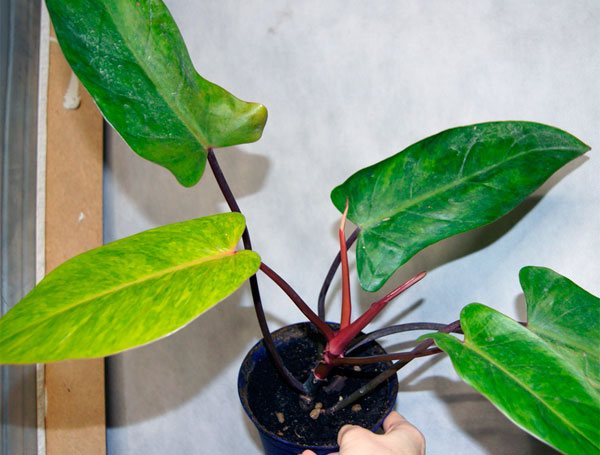

That is why it is better not to plant a philodendron in heavy fertile soils - abundant watering of such land can lead to waterlogging. It is better to prefer a light substrate: 3 parts of garden land, 2 parts of peat, 4 parts of bark for growing orchids and 1 part of perlite. There is an easier option: turf and leafy land with sand in a ratio of 1: 3: 1. Ready-made soil for Saintpaulias is also suitable. It will be useful to add sphagnum and charcoal to the soil.
Philodendron can be fed with organic fertilizer quite often. The mode depends on the concentration: you can feed the plant once a week with a fertilizer diluted twice or three times, and an undiluted portion is given once every 2 weeks. In winter, 1 top dressing per month will be enough. You should not be zealous with feeding young plants - they are reluctant to release new leaves from a large amount of fertilizer. You also need to be very careful with the amount of nitrogen - there should not be a lot of it in fertilizers.
A native of the hot tropics, philodendron loves warmth... The optimum temperature for him is 22-30 degrees. In any season, it should not drop below +13. In addition, the soil should also not freeze - its temperature should be similar to room temperature. Therefore, you should not put the pot with the philodendron on a cold windowsill or floor in winter - you need to come up with some kind of stand.
The transplant is carried out as needed. If you see that the overgrown roots have already entangled the entire earthen lump, sticking out of the drainage holes, and the size of the vine implies a larger capacity, then the time has come. Also, a sign that it is time to transplant a philodendron is a salt deposit on the surface of the soil, its strong compaction or the appearance of moss.
They are engaged in transplanting in April. Typically, young and fast-growing philodendrons are transplanted once a year. Adults need a transplant no more than once every 2-3 years. For an oversized specimen, you can simply replace the topsoil.
Water procedures
Large philodendron leaves require regular rubbing with a damp cloth, as dust accumulates very quickly on them. However, it is necessary to carry out this procedure with great care: the strong-looking leaves of the creeper are actually very fragile and easily torn from careless movement. Don't forget to wipe down the shoots too.
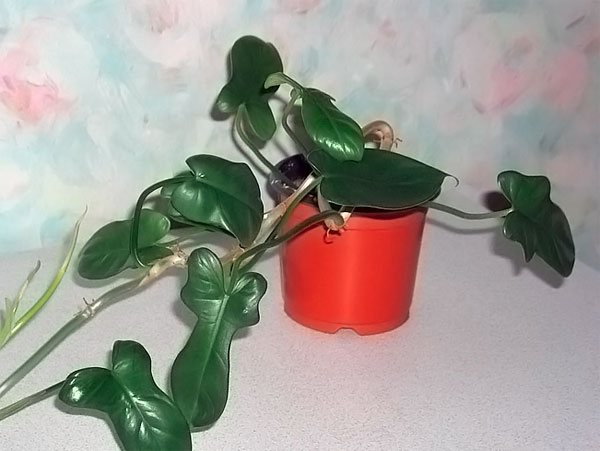

The velvety leaves do not need rubbing, but they can be sprayed. True, only the smallest spray nozzles are suitable for this. In general, spraying is relevant for all varieties: the tropical philodendron is very fond of high humidity.It is provided by spraying the air around the plant or placing a container with it on wet pebbles or expanded clay.
Vines are also given a bath - usually once a week. The pot with the plant is lowered into a bucket, allowing the soil to be well saturated with moisture. The props are also moistened if they are wrapped in moss or made of coconut fiber.
In general, the unpretentious philodendron has long been accustomed to the dry air of apartments (excluding some particularly capricious species that grow well only in greenhouses). However, additional moisture will undoubtedly benefit the vines.
Good ventilation is required in high humidity.
Features of planting and transplanting
Plant location
Philodendron is a shade-tolerant plant. But with insufficient illumination, the shoots will stretch out, the leaves will shrink, and varieties with variegated leaves will lose their color. Direct sunlight will also not be beneficial. The best option is to put the plant near the east window. If the windows face south, then it is better to hide the philodendron in the middle of the room.
Protect the philodendron from drafts!
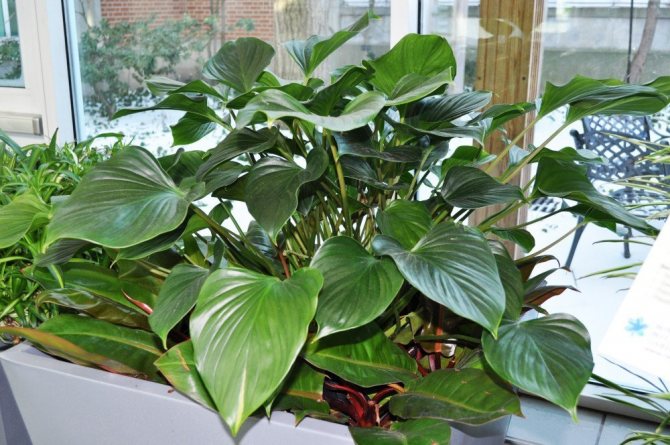

The best place for the plant will be the east window.
Landing rules
The new planting pot should be high enough and with a wide top, taking into account the fact that the aerial roots of the philodendron can take root, and 5-7 cm higher than the previous one. Too large a pot can cause waterlogging of the soil, which is undesirable. Drainage holes are required.
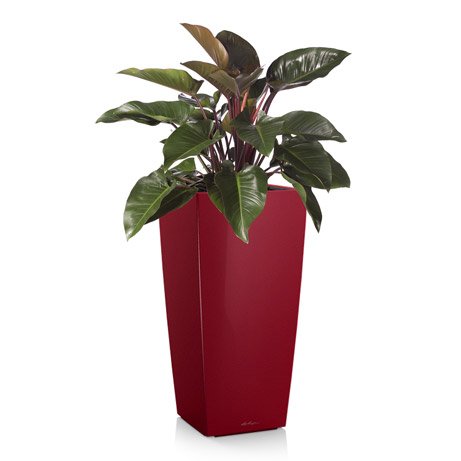

A tall pot is suitable for a philodendron
In nature, philodendrons grow on soils that include fallen leaves and decayed wood. When buying an earthen mixture in a store, you should opt for light earth for Saintpaulias. The main requirement for the soil is good water and air permeability. If you decide to prepare the mixture yourself, then you will need:
- 3 parts of garden soil;
- 2 parts of peat;
- 4 parts orchid bark;
- 1 part perlite.
There is another option, which includes:
- 1 part of sod land;
- 3 pieces of sheet;
- 1 part sand.
Horn shavings or bone meal can be added to the earthen mixture to make the soil more nutritious.
The finished mixture should be light and loose, easily permeable to water, with neutral or weak acidity, pH 5.5–7.
Don't forget to prepare the support. You can buy it in the store, or you can make it yourself. For small plants, it is better to make a rigid wire frame or put a trellis. For more impressive specimens, take a wooden stick, branch or piece of plastic pipe and wrap it with fibrous material or sphagnum moss. The philodendron curling along the support will take up little space in the apartment.
The support must be wet. During the period of active growth, it is sprayed with highly diluted fertilizers.
Transplant features
Adult plants are transplanted every 2-3 years, and young plants are transplanted annually. On specimens that are too large, the topsoil can be renewed without replanting. To do this, remove 5 cm of the old soil and replace it with a new one.
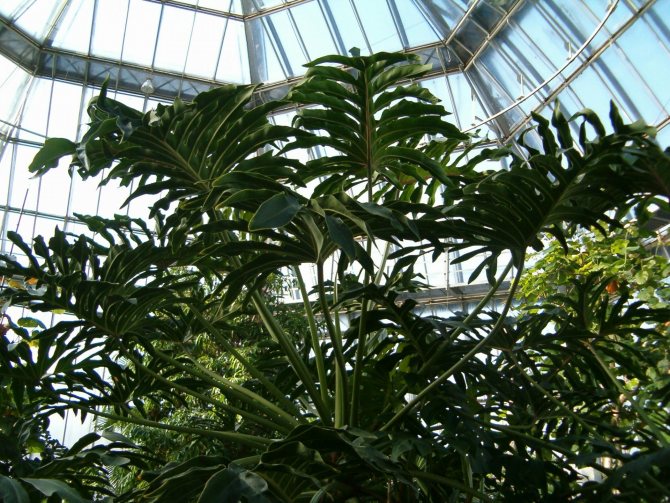

In large specimens, it is enough to change the top layer of the earth to a new one every year.
The best time to transplant a philodendron is spring.
The transplant is carried out in the following cases:
- The soil is compacted or covered with moss.
- The roots grow through the drainage holes, or the leaves become smaller, indicating a cramped pot.
- Mineral substances accumulate excessively, which appear in the form of white streaks on the soil.
- The presence of pests or signs of philodendron disease in the soil is observed. In this case, it is necessary to remove the old soil and cut off diseased roots.
When transplanting, do not forget to disinfect the soil by pouring boiling water over it or frying it in the oven.
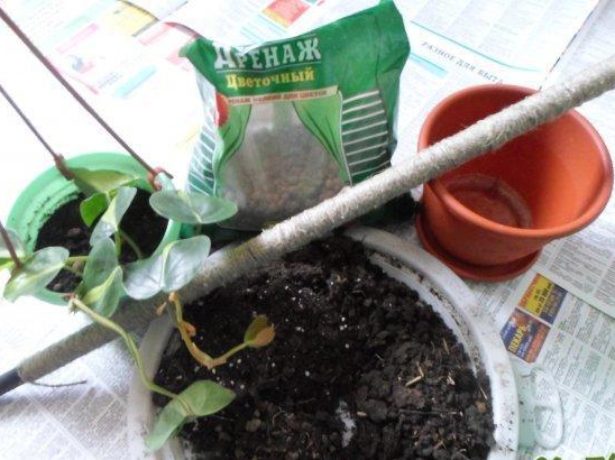

The plant should be transplanted immediately after purchase.
Step-by-step transplant process:
- Place a layer of drainage in the prepared pot.
- Top up with a layer of soil.
- Carefully remove the philodendron from the old pot, trying to keep an earthen ball and not disturb the roots.
- Place the plant in the center of the new pot along with the support. If you stick it after planting, you can damage the roots.
- Top up the soil from all sides, then spill it with water. The soil will settle and fill all the voids. Add the remaining soil and water again.
- When planting, do not deepen the root collar.
If you bought a philodendron in a store, then when you come home, carefully remove the plant from the pot and inspect the root system. If the roots are completely entwined with an earthen lump, then a transplant is necessary.
Philodendron transplant by transshipment method - video
Philodendron Diseases and Growing Difficulties
| Problem | Cause |
| The tips and edges of the leaves dry out | Insufficient watering |
| The tips and edges of the leaves dry out | Air is too dry |
| Leaves shriveled and turned brown | |
| The tips and edges of the leaves dry out | Too poor watering |
| Leaves lose their variegated color and characteristic dissection | |
| The brown edge at the edges of the leaves is widening | Excessive watering |
| Leaves grow small | |
| Small and pale new leaves | Little light |
| Elongated shoots | |
| Leaves lose their variegated color and characteristic dissection | |
| Light or brown dry spots on the leaf surface | The sun is too bright |
| Pale leaves | |
| Leaves curl down | Oversupply of fertilizer |
| New apical leaves grow small and yellow | Lack of fertilizer |
| Leaves lose their variegated color and characteristic dissection | |
| Leaves lose their variegated color and characteristic dissection | Hypothermia |
| Leaves turn black |
Among the pests that the philodendron is susceptible to attack are traditional scale insects, mealybugs and spider mites. The methods of dealing with them are simple - store-bought or even folk remedies.
A serious cause for concern is the rotting of the stems of the philodendron. This is most often due to the fact that the vine growing in heavy soil was watered excessively at low temperatures.
But the yellowing and dropping of the lower leaves is a natural process of plant aging.
Another natural phenomenon is the appearance of water droplets on the leaves of the philodendron. This happens before rain and is caused by high humidity, when the plant can no longer evaporate moisture into the air due to its excess. In this case, it is necessary to postpone the humidification, perhaps even to reduce watering.
Ornamental plant philodendron "Atom"
The most difficult to care for of all the species presented is the Atom philodendron or the compact Sello variety. The ornamental plant has a bright green color and glossy shine, five-lobed leaves are the main distinguishing features of this species. Very sensitive to the environment, therefore it is important to maintain a high level of humidity. Otherwise, the plant dies. It is also important to water the plant constantly, but reduce the amount of watering in autumn. In this case, the water must be necessarily settled or boiled. Otherwise, they are as unpretentious as the other types of philodendrons described above.
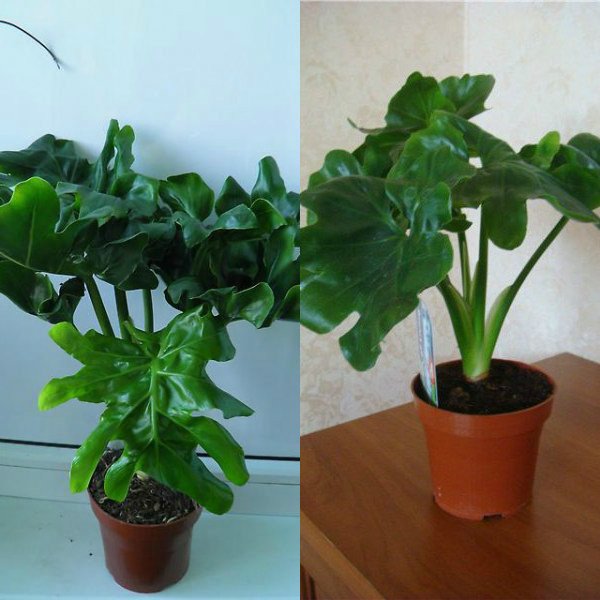

At the initial stages of growth, the trunk is slightly inclined, has aerial roots. It is important to remember that the roots are very sensitive to water. Therefore, in search of her, they can easily overcome several meters, for example, to the aquarium.
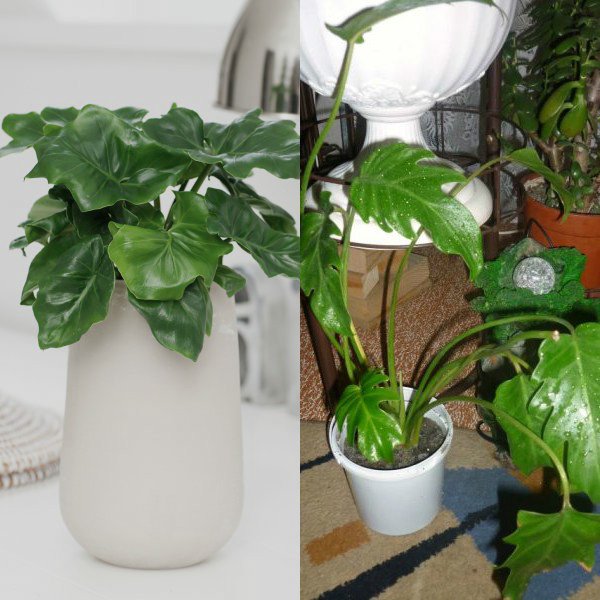

How can you propagate a philodendron yourself
Most often growers propagate philodendron by cuttings - this is the easiest and most reliable way. Both apical and stem shoots are suitable - the main thing is that they have at least two leaves. The most suitable case: a site with aerial roots. The cuttings are planted in sphagnum or a sand-peat mixture, covered with a transparent film and the temperature is maintained at 25 degrees above zero.
Cuttings of some philodendron varieties root well in water, but soil rooting is still preferable, because in this case the roots do not have to adapt when transplanted into the ground.
If rot appears on the cut, the damaged area is cut off and the cut is treated with crushed coal. After that, you can try to root the sprout in the soil again.
You can also root a stem cutting without leaves. Place it on moistened moss and place the container in a warm place. Perhaps the roots will not appear at the cutting, but the bud will wake up, from which the shoot will sprout. When it reaches 5-6 cm, it is cut and rooted. And on the "hemp", after a while, a new bud may sprout.
In order to propagate a philodendron with a leaf, the leaf is cut off from the heel and placed in water. You can plant it in light soil, but in this case, the container must be put in a bag and regularly ventilated. It will be possible to understand that the plant has successfully rooted by the appearance of a new leaf.
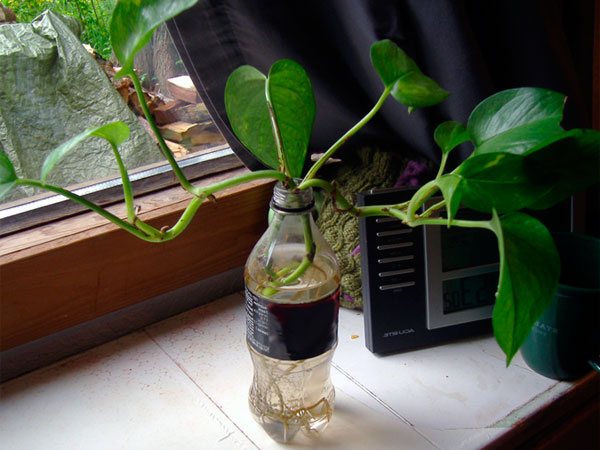

When propagating by air layers, the shoots of lianas are simply fixed on the ground until roots appear in their nodes. As soon as this happens, the rooted shoot is cut off from the parent plant.
In the case of tree philodendrons in the spring, an annular incision is made on their lignified trunks. A second one is made 3 cm lower or higher, and the bark between them is removed. The naked cut is treated with a root former, wrapped in moistened moss and wrapped in polyethylene.
The moss needs to be constantly moistened, and then after a few months roots will appear there. A couple of months after their appearance, the film and moss are removed, the trunk under them is cut off and planted in a container. Do not rush to throw away the remaining stump: most likely, over time, new shoots will appear on it.
Care features
A prerequisite for caring for a plant is accuracy and care when wiping the leaves and replanting. The reason is that aerial roots not only cannot be cut off, but they can also be touched as little as possible. The sap of the plant is poisonous and can irritate the mucous membranes of the eyes and skin. Therefore, all work should be carried out with gloves.
Liana philonderons are grown on supports wrapped in moss or any soft textured substitute. Shoots should not come into contact with wood and hard metal. Low humidity and improper growth conditions lead to colonization of the plant with scale insects, which are fought with insecticides.
Dormant period
Philodendron has a poorly expressed rest period. This is rather due to the reluctance of the grower to provide the flower with regular watering, good lighting and a warm winter. Then, the flower pot is moved to a cooler room with a temperature of about 18 - 20 grams, the frequency of watering and dressing is reduced. They stop sprinkling its leaves and air. Lighting does not play a big role, it can be natural or artificial, as long as the flower is in a bright place. This lasts from late December to early March.
Secret number 1. Individual approach
The main, and perhaps the most reliable advice that can only be given (and received) when buying a philodendron is to study all the features of a particular species and even a variety. Indeed, these plants and individual varieties are more hardy than other varieties. And the "spread" in terms of requirements for growing conditions and care for different types of philodendrons can be very large. Some plants are better suited to indoor environments or specific locations than others. So, shade tolerance is an excellent characteristic of the variety. philodendron ivy (Philodendron hederaceum
)
- philodendron climbing (Philodendron hederaceum
var.
hederaceum
), which can be used for full-fledged landscaping in the back of the room. He can be accompanied by
philodendron blushing (Philodendron erubescens), but other species grow better in a diffused light place and in partial shade. Philodendron bipinnate (Philodendron bipinnatifidum) - with its almost meter-long beautifully cut leaves - not the best candidate for small rooms and apartments. In any case, when buying, it is worth checking how demanding your philodendron is for air humidity, what maximum size it can reach, and whether it is easy to control. With such a check, you will save yourself from dozens of problems.
Philodendron climbing, or Philodendron clinging (Philodendron hederaceum var.hederaceum) Philodendron reddish, or Philodendron blushing (Philodendron erubescens) Philodendron bipinnate, or Philodendron double-periston cut, or Philodendron Cello (Philodendron bipolar)
Reproduction methods
Since the philodendron rarely blooms at home, therefore, the seed propagation method is practically not used. Better to breed it vegetatively.
Cuttings
Take a small plant stem with 2-3 internodes. Lay it horizontally in a peat and sand substrate. Deepen at an angle of 30-40 °. Cover with foil and transfer to a room with a temperature not lower than + 25 ° С. After rooting, remove the film and transplant the cutting into an appropriately sized pot with suitable soil.
Pieces of stem
Some types of philodendron (for example, Selo) reproduce well with pieces of the stem. It is necessary to put a piece of a plant with several buds on moist soil. After a few weeks, air roots will separate from them and lateral shoots will begin to appear. This is a finished plant that can be transplanted into a new pot.
Secret number 9. Be gentle with philodendron fertilization
Philodendrons fertilize frequently and for an extended period. Top dressing for this plant is carried out every 2 weeks, from March to September. But if the philodendrons are transplanted, then feeding is not carried out for another 4-6 weeks after the procedure. The first feeding is carried out with a halved dose and then, until the normal schedule of these procedures resumes, another pause of one month is made. To find the perfect schedule, you need to keep an eye on the plant. With a lack of fertilizers, the philodendron becomes smaller, the leaves turn yellow and dry, growth is clearly slowed down, the trunk is thinner than usual. When overfeeding, the tips of the leaves turn yellow and turn brown, the leaves become lethargic and lose their elasticity. An excess of nitrogen, which causes rapid growth, is especially dangerous for the philodendron (accordingly, and vice versa, if you reduce the feeding with nitrogen, the plants can be controlled in growth).
When choosing fertilizers for philodendrons, you should not be fooled by the beauty of their leaves: for this plant, it is better not fertilizers for decorative deciduous crops, but complex universal fertilizers.
But the main rule of fertilization for the philodendron concerns the procedure itself: always feed the philodendron after abundant watering. This is the only way to protect the plant from a high concentration of salts and the only way to feed the philodendron so that it does not perceive the feeding procedure as an excess of fertilizer in the soil.
Secret number 8. Take your time with a philodendron transplant
Philodendrons belong to those indoor crops that do not need to be replanted annually, even at a fairly young age. The growth rates of the aerial parts do not always correspond to the growth of the rhizome. Increasing the pot size by 3-4 cm during transplanting ensures that the philodendron will need to be transplanted only after a year. And more mature plants can be transplanted once every 3 years. The optimal period is not February - early March, but late March - early April. When transplanting, carefully monitor that the level of penetration remains the same and lay a new drainage. And for climbing philodendrons, any transplant is completed with a very simple procedure - pinching the ends of all elongated or simply too long shoots.
In years when no philodendron transplant is carried out, replace about 5 cm of the top of the substrate.
When choosing a substrate for a philodendron, give preference to special mixtures for decorative leafy crops. Other slightly acidic or neutral, coarse-grained, light, nutritious and loose soil mixtures are also suitable.
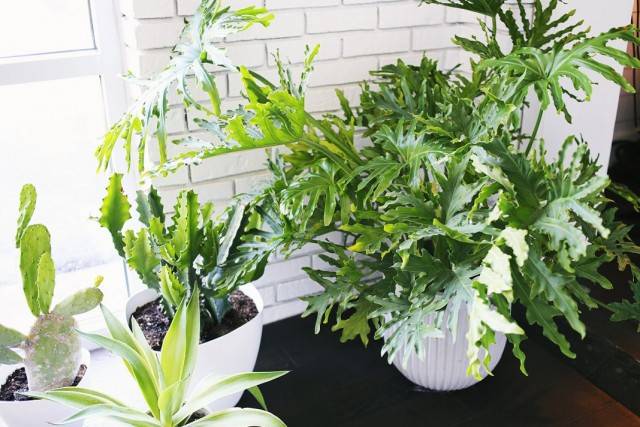

Philodendron bipinnate, or Philodendron double-periston cut, or Philodendron Sello (Philodendron bipinnatifidum)
Useful tips for growing
It is very important to monitor the level of moisture in the soil and air. Deviations in this regard, namely, too dry air and overdried earthy clod, as well as excessively humid air and constantly wet earth, reduce the immunity of the plant, increase the risk of disease and create favorable conditions for the appearance and reproduction of pests.
Did you know? Inside the philodendron there is a milk-juice containing rubber. In the homeland of the plant, this poisonous substance is used to jam fish, as well as to solder air guns.
Philodendron can embellish any room with its exotic grace. And looking after him is not at all difficult. Even a novice florist can easily cope with this.
1. Seven Secrets of Success:
| 1. Growing temperature: summer - 18 - 27 ° С, winter - a cool dormant period at a temperature of 17 - 20 ° С. |
| 2. Lighting: shading from direct sunlight, the philodendron can receive direct sunlight in the morning and evening in spring and summer. In autumn and winter, bright lighting throughout the day. |
| 3. Watering and humidity: a well-moistened substrate during the growing season, in winter in accordance with the air temperature in the room - dry the substrate half the depth and more between waterings. Air humidity increases with the onset of hot weather. |
| 4. Pruning: Formative pruning is not required for most varieties. A sanitary one is needed as needed, when it is worth removing old, yellowed leaves. |
| 5. Priming: a nutritious and loose substrate with a high organic content, with a neutral or slightly alkaline pH. |
| 6. Top dressing: during the entire growing season - mineral fertilizers or organic matter every 2 weeks. In the fall, feeding is reduced, and in the winter it is stopped altogether. Fertilization is resumed in the spring when young leaves appear |
| 7. Reproduction: stem or apical cuttings in early spring, sowing seeds. |
Botanical name: Philodendron.
Philodendron home - family... Aroid.
Homeland of the plant... Central America.
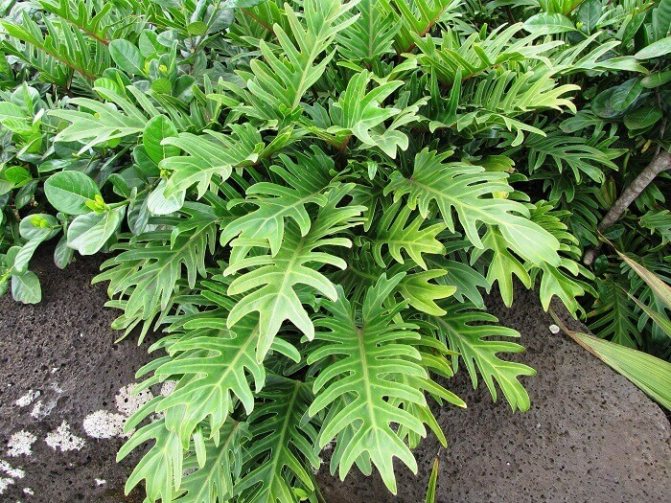

Description... Philodendron is an extensive and very diverse genus of plants, including about 500 species of lianas and shrubs, among which there are evergreen and deciduous species.
Many plants have long aerial roots on the stems.
Shape and size sheet plates extremely varied, as well as their shade. The leaf petioles are long.
During the flowering period, plants form inflorescences - cobs surrounded by thick blankets.
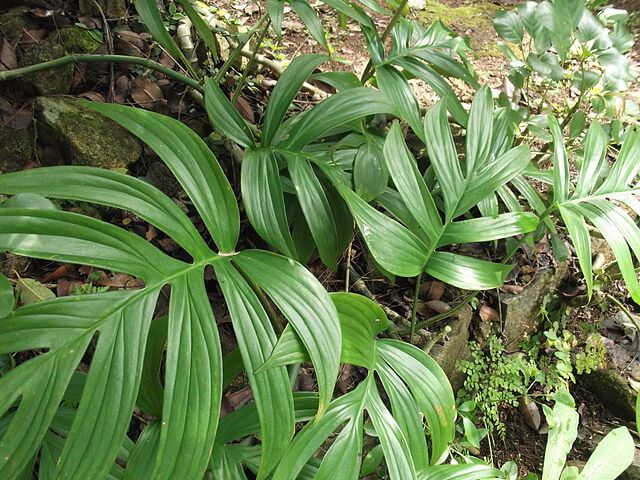

Height... Philodendron flower growing rapidly — for the season able to add 50 - 100 cm. Height.
The final height of the plant varies greatly and depends on the specific species.
Watering
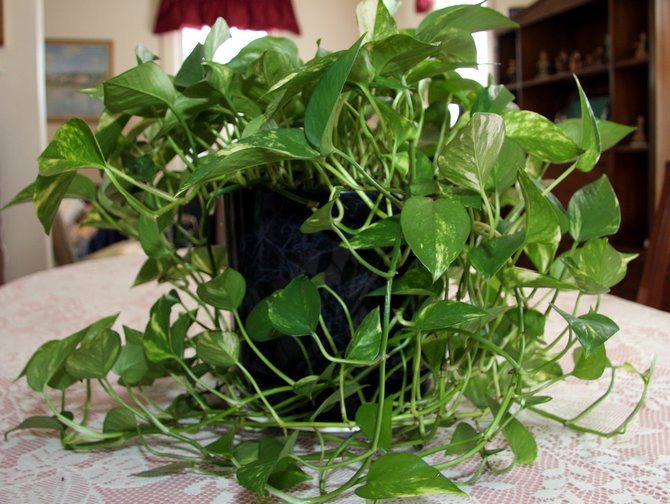

The soil in a pot of any kind of Philodendron should always be slightly moist, that is, moisture should always be present at the roots, but not stagnate there. Stable, constant moisture in the substrate is a guarantee that the flower will feel good. In drought, the leaves will dry out and fall off, and with excessive watering, they will turn yellow. Water the next time when the topsoil is two fingers dry. Regardless of the season. Only in summer will the soil dry out much earlier, and in the heat you will water almost daily, and in winter - once a week or less.
Monitor the condition of the soil and do not forget that Philodendrons love slightly moist soil, not weeping soil. Use water for irrigation that is settled, slightly warmer than room temperature.If you water this flower with tap water, it will quickly lead to salinization or alkalization of the soil and provoke the death of the plant. But rain or melt water will do just fine. Drain excess water from the pan immediately.
Debunking the Philodendron myths
Various mystical properties are attributed to the plant. One of the beliefs claims that the flower supposedly expels men. Therefore, it cannot be kept by married couples. Another superstition says that a philodendron in the house is a loss of health.
There is no smoke without fire. Perhaps these beliefs are based on stories about the pioneers of South America, who, in the process of colonization, went deep into the jungle and died there. Newspapers of the 19th century were full of reports of people attracted by the scent of a killer tree and strangled by a vine.
In fact, the adventurers died, of course, for quite natural reasons: from thirst, hunger, loss of blood. But this is probably the origin of the myth: the smell of a flowering plant is extremely dangerous to human life, and its juice is poisonous.
Indeed, in the complex, which includes more than 20 components, the composition of the curare poison, the Indians of Guiana, added fermented squeeze from the juice of a rare species of flowering philodendron. But this fact refers to the rarest representative of the philodendron family, which grows in hard-to-reach places in South America.
In our time, the research of the CIA polygraph examiner Cleve Baxter, who revealed a sharp, human-like reaction of a flower to aggression, added fuel to the fire. In fact, the presence of perception (sensory perception) to one degree or another is present in all the inhabitants of the plant world.
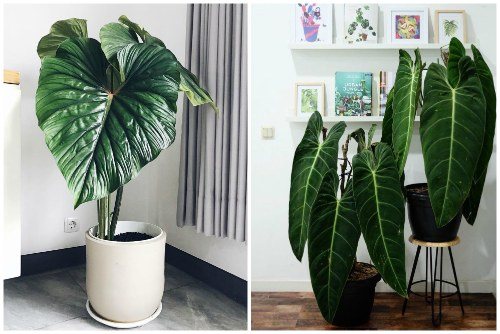

Secret number 7. Support and air humidification
Most indoor philodendrons are vines. And for success in growing them, do not forget to moisturize the supports (if, of course, you use the support, which is usual for these plants, covered with moss or synthetic substitute material). The support should never dry out completely.
But this is not all the measures for humidification: philodendrons also love high air humidity, so additional measures need to be taken for the plant. Spraying is not the best option. For philodendrons, it is better to choose a simple way with a "handicraft" or home humidifier - placing stands or pallets with moisture-retaining materials.
Do not forget to wipe the leaves from dust - any philodendron responds to such care with a brighter color.
Flower support
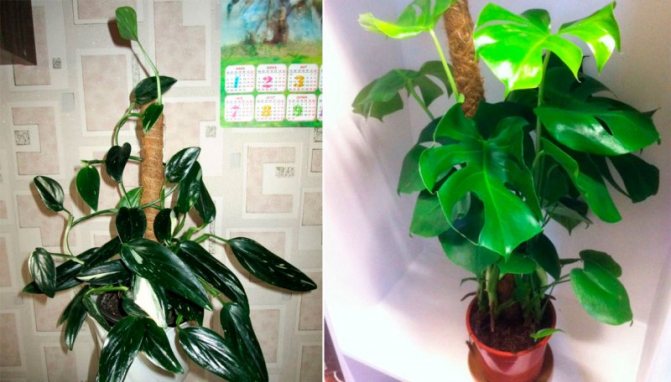

You can look for a suitable support in the store, or you can make it yourself. For small specimens, a rigid wire frame or a beautiful lattice is suitable. For larger plants, you need to come up with something more solid. Wrap, for example, a piece of plastic pipe or a wooden stick with sphagnum moss or fibrous material. Place the support in the flower pot during transplanting.
Attach the aerial roots and stems of the plant to the support so that it does not interfere with the growth of the leaves. Make sure the support is always wet. During active growth of Philodendron, in spring and summer, spray the support with low concentration fertilizers. A flower curling along the support will decorate the interior and take up little space in the room.
Secret number 4. Add a couple of degrees to the minimum temperature
In the recommendations for growing philodendrons, you can often find the minimum allowable temperature of 13 degrees. It is better not to bring the situation to such a decrease. Limit the temperature range in winter to just 16 degrees. And then you will prevent most of the problems and difficulties that can arise in the cultivation of philodendrons.
As for the air temperature from spring to autumn, the room values for philodendrons will be comfortable (from 20 to 25 degrees). Higher rates, however, are not.In order for philodendrons to maintain high decorativeness in the heat, you will have to make efforts to control more abundant watering and an increase in air humidity. But the main thing is to protect the plants from temperature extremes. Do not place any heating devices near philodendrons, protect plants from air conditioners and even ventilation in cold weather.
Just by stabilizing the temperature and observing the minimum indicators, you guarantee yourself that the leaves on your philodendron will not become shallow, and growth and development will occur evenly.
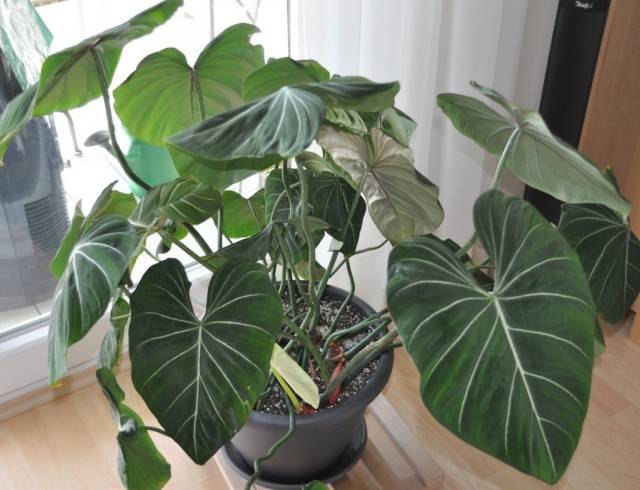

Philodendron gloriosum
Testimonials
It grows quite quickly, at work this liana has grown more than 4 meters. In a very bright place, its leathery spear-shaped leaves acquire a bronze tint. The wrappers of young leaves are very beautiful - they are almost red. A completely unpretentious plant, suitable even for northern windows. In the summer I take him to the balcony - he feels great there even in the heat. With a lack of moisture, the leaves wilt slightly, but after watering the turgor is restored. It can grow like a liana or, if pruned, like a "bush".
Svetlana Yurievna
The plant is very unpretentious and very grateful, persistent in its desire to survive and grow further))) It grows slowly - by about 1 cm per year.
keygen
Very unpretentious! Calmly tolerates low air humidity and short-term overdrying of an earthen coma. If you give him nutritious, loose, slightly acidic soil and diffused light, then there will be no problem! A very grateful and sympathetic plant!
sweetsvetulia
Pests
Philodendrons, which are regularly observed, are sprayed in hot weather, bathed in the shower and wiped dust from the leaves and uninvited guests, as a rule, are not attacked by pests. But on a plant that is not looked after as it should, all kinds of parasites can settle. Let's take a look at some of them in order.
Spider mite
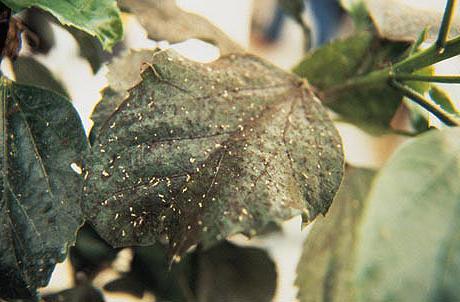

You can find ticks by a light white cobweb that braids the leaves and shoots of the plant. The surface of the leaves is covered with small white dots - these insects pierce the leaf tissue and suck out the juice. Spider mites are located on the underside of the leaves in colonies. The color of insects is brown, red, green. Mites appear when the indoor air is too dry. Therefore, the first step is to increase the humidity near the flower bushes, and the affected plant, if its size allows, take it to the bathroom and under a warm (37-40 g) shower try to bathe so as to wash off as many insects as possible from the leaves and stems. Cover the soil with polyethylene to prevent water from entering the pot.
Treat large, heavy specimens with insecticides on the spot (Aktara, Actellik, Fitoverm) strictly according to the instructions, opening the window for a while. Gloves and a gauze bandage are also desirable.
Shield
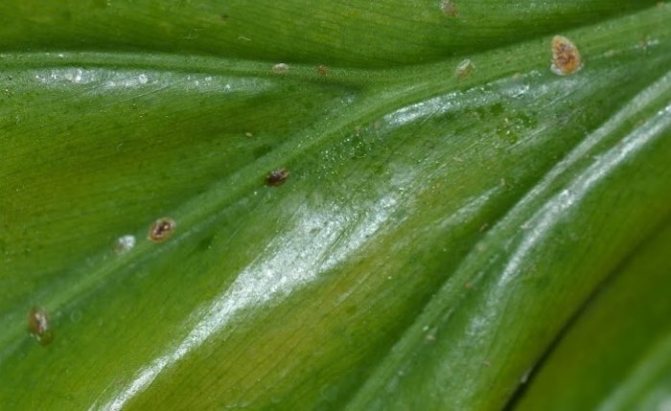

Small bumps of light brown light on the surface of leaves and stems indicate that Philodendron was attacked by a scale insect. Young larvae quickly spread throughout the plant, so you can't hesitate. Adults can be removed mechanically. With a cloth dampened in alcohol or soapy water, remove the shield from the plant, using tweezers or a scalpel to help yourself. This procedure should be repeated for several days while you find the pests. On large specimens, it is difficult not to miss small pests, so we advise you to treat the plant affected by the shield with insecticides, as with the spider mite.
Aphid
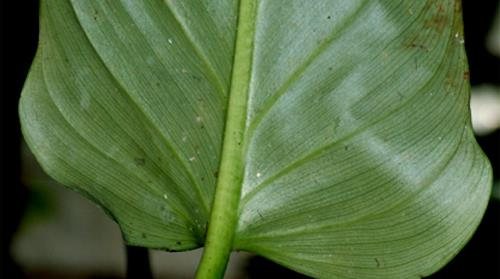

These insects of gray, black or green color settle on the apical shoots and on the underside of young leaves. They multiply rapidly and suck out the sap of the plant at great speed. If urgent action is not taken, the flower may die. If Philodendron is minor, remove insects with a sponge and soapy water. Otherwise, treat with insecticides as in other cases.
Mealybug
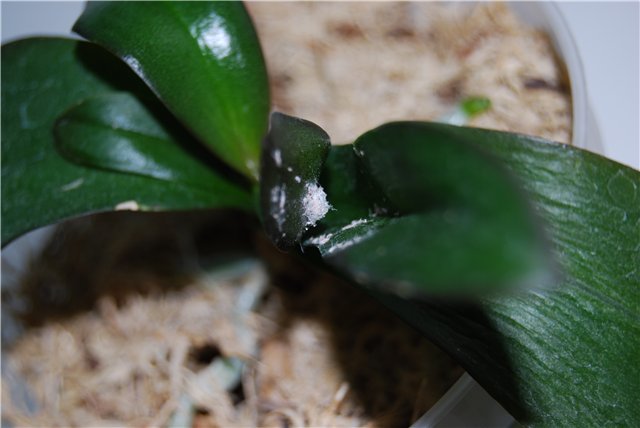

This insect can be detected by the white cotton-like lumps that cover the young shoots and leaves of the plant. This is also a sucking insect. The affected parts of the Philodendron turn yellow and fall off. Pests should be removed with a napkin soaked in sports. Then wash the plant in the shower. Treat heavily infested bushes with chemicals as described above.
Thrips
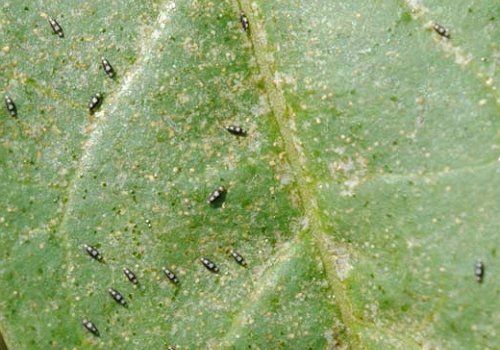

These small (up to 1.5 mm) winged insects live in the soil, but can fly. They can be found on the surface of the soil and by the gray-brown bloom on the surface of the leaves. Try to wash off these insects in the bathroom with soapy water. It is advisable to change the soil in the pot. If this is not possible, then remove, as much as possible, the top layer of the substrate and pour in a new one. Water the potting soil with water and an insecticide that you use to spray the entire plant after bathing.
Location
Potted Philodendron species grow well on east and west windowsills. On southern windows, they should be protected from the sun with blinds or light curtains. Ampel species and vines are best placed a little in the back of the room. Northern windows are not suitable for all varieties, you may have to use fluorescent lamps or phyto lamps for illumination.
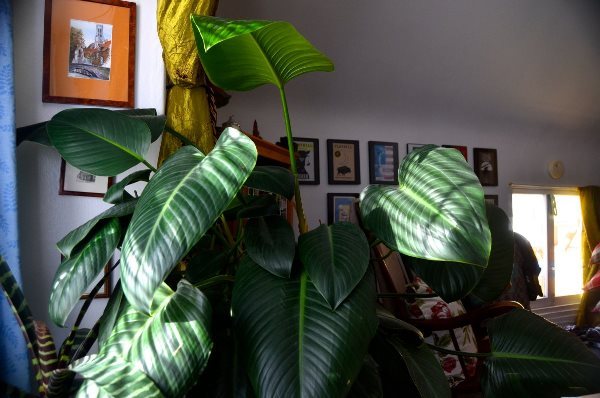

When buying a plant, check its dimensions. If you have a spacious home, then feel free to buy luxurious Philodendron views with huge velvet leaves. Otherwise, choose a plant with a more modest size - then in the future you will get rid of many problems.
If you grow Philodendron in a place of an apartment or office where there is no natural light, but the light is on almost all day long, then, we assure you, the flower will adapt to artificial lighting and will grow in the same way as on a lighted windowsill. So feel free to put a flowerpot with a flower in a wide hallway, in the corridors of the office, in the passages between rooms, even in a spacious bathroom.
Many indoor lianas, after spending the summer outdoors, become more beautiful and decorative. But Philodendrons do not like this. Even small curly species of Philodendrons do not like moving to the balcony or garden, and even large specimens - even more so. The thing is that Philodendrons do not tolerate sudden movements of air masses and temperature changes. They absolutely do not tolerate drafts. And in the fresh air, all this happens all the time, even in the most protected places.
If you have large indoor palm trees, we advise you to plant Philodendron varieties with small leaves in a tub to create an elegant green litter.
Secret number 2. Philodendron's shade tolerance has limits
If your philodendron is not a shade-loving species and varieties that can tolerate less light, consider a philodendron a plant that needs good lighting. It is in such places that most of the species of these plants reveal their beauty best. Direct sunlight is contraindicated for any philodendron, but shading can only be light. When choosing a place in the room for the philodendron, try not to move too far from the window and stay within locations with good lighting.
Secret number 12. To propagate a philodendron, choose a cuttings method
It is the rooting of apical cuttings or parts of the stem with side shoots that is the easiest way to get a new philodendron. With the second method of cuttings, make sure that leaves develop on the side branches. At the first - cut not short cuttings, but the tops 12-15 cm long. In any case, it is better to root cuttings in wet peat or peat substrate in greenhouse conditions and with very strict temperature control: the permissible range is from 20 to 22 degrees.
www.

